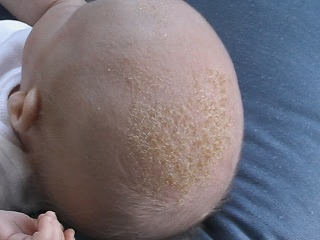Seborrhoeic dermatitis in babies
Cradle cap
Peer reviewed by Dr Colin Tidy, MRCGPLast updated by Dr Toni HazellLast updated 25 Apr 2022
Meets Patient’s editorial guidelines
In this series:Seborrhoeic dermatitis
Seborrhoeic dermatitis in babies causes bad dandruff (cradle cap). It sometimes causes a rash on other areas of the skin. Treatment is not usually needed, as it does not normally cause any discomfort and usually clears on its own.
In this article:
Continue reading below
What is seborrhoeic dermatitis (cradle cap)?
Seborrhoeic dermatitis in babies is a type of skin inflammation which mainly affects the scalp and face. The exact cause of seborrhoeic dermatitis is not known. It is thought that babies who develop seborrhoeic dermatitis may produce more oil (sebum) from the sebaceous glands in their skin. Yeast germs from the Malassezia species may also be involved . However, seborrhoeic dermatitis is not just a simple skin infection and you cannot catch this condition from others (it is not contagious). The fungal germ lives in the sebum of human skin and some babies may react to the germ in some way which causes the skin inflammation.
Many babies have a mild form of seborrhoeic dermatitis within the first six months of life but it usually goes away on its own after a few months. In most children, cradle cap has cleared by the age of 6 months. It does not usually occur in older children. Some teenagers and adults have a related condition which causes bad dandruff and a rash. See the separate leaflet called Seborrhoeic Dermatitis (Dandruff) for more details.
What are the symptoms of seborrhoeic dermatitis in babies?
Symptoms include:
Cradle cap. This is areas of greasy, yellow, scaly patches on the scalp. In some cases a thick scaly layer covers the whole scalp. Over time the scales may become flaky and rub off easily. Cradle cap is not usually itchy and, in most cases, the baby is not aware of any problem or discomfort.
Cradle cap

Image via Wikimedia Commons
Rash. In addition to cradle cap, some affected babies develop a mild red rash. This can appear on the eyebrows, on the skin next to their nose, or in the creases of the skin such as around the neck, behind the ears or in the armpits. Sometimes it can cause a kind of nappy rash in the groin creases.
Cradle cap most commonly develops in the first six weeks of life. It tends to last a few weeks or months and then goes.
Continue reading below
What is the treatment for seborrhoeic dermatitis in babies?
Treatment for seborrhoeic dermatitis is not usually needed, as the condition is usually mild, is not serious and does not usually cause any discomfort to the baby. Seborrhoeic dermatitis will usually clear up by itself eventually.
However, the appearance of the scalp can be improved by daily washing with a baby shampoo followed by gentle brushing with a soft brush to loosen scales. Alternatively, soften the scales with baby oil first, followed by gentle brushing and then washing off with baby shampoo. If this does not work, it may be helpful to soften the scales by rubbing in olive oil, vegetable oil or white petroleum jelly. Leave this in overnight to allow it time to work. Wash it off with baby shampoo in the morning. Another option is to try a greasy moisturising lotion (emollient) such as emulsifying ointment.
If other areas are affected by seborrhoeic dermatitis, regular washing helps. Use an emollient cream instead of soap on the affected skin.
If needed, a medicated antifungal cream may be prescribed by your doctor. Creams which may be used are clotrimazole, econazole or miconazole. This will usually clear the rash. Rarely, if inflammation is more severe, a mild steroid cream may be prescribed by your doctor.
Further reading and references
- Cradle cap (infantile seborrhoeic dermatitis); DermNet NZ
- Hald M, Arendrup MC, Svejgaard EL, et al; Evidence-based Danish guidelines for the treatment of Malassezia-related skin diseases. Acta Derm Venereol. 2015 Jan;95(1):12-9. doi: 10.2340/00015555-1825.
- Seborrhoeic dermatits; NICE CKS, February 2022 (UK access only)
- Seborrhoeic dermatitis - infants (Simple advice); NICE CKS, February 2022 (UK access only)
Article History
The information on this page is written and peer reviewed by qualified clinicians.
Next review due: 24 Apr 2027
25 Apr 2022 | Latest version

Feeling unwell?
Assess your symptoms online for free